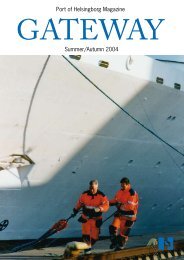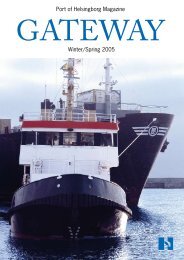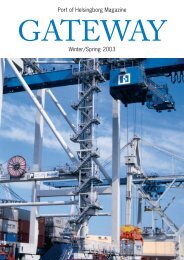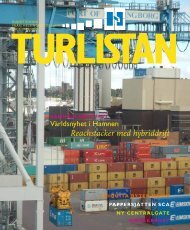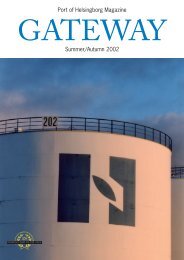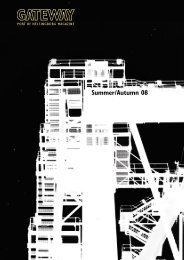Port of Helsingborg Magazine Winter/Spring 2006 - Helsingborgs ...
Port of Helsingborg Magazine Winter/Spring 2006 - Helsingborgs ...
Port of Helsingborg Magazine Winter/Spring 2006 - Helsingborgs ...
Create successful ePaper yourself
Turn your PDF publications into a flip-book with our unique Google optimized e-Paper software.
Peak season for clean heatingat VästhamnsverketVästhamnsverket’s peak season is from December to March.Öresundskraft’s, the local energy company, bi<strong>of</strong>uel plantuses about 1,000 tonnes <strong>of</strong> pellets a day, with shiploads <strong>of</strong>these compact little pieces coming from Sweden, the Balticcountries and North America. In one year, production <strong>of</strong>district heating here amounts to the equivalent <strong>of</strong> the annualconsumption <strong>of</strong> 40,000 ordinary private houses.The pellets warehouse seen from crane 18It is an intensive period at Västhamnsverket.The operational seasonstretches from mid-October until themiddle <strong>of</strong> May, but production is at itsheight during the coldest months. Sincethe turn <strong>of</strong> the year, coal is no longerburned and only bi<strong>of</strong>uel in the form <strong>of</strong>wood pellets is transformed into heatand electricity. Efforts to reduce theamount <strong>of</strong> coal used have been goingon for many years, and the fi gures telltheir own story. Before, the use <strong>of</strong> coalresulted in emissions <strong>of</strong> 310 tonnes <strong>of</strong>nitrogen oxides, 160 tonnes <strong>of</strong> sulphurand 330,000 tonnes <strong>of</strong> carbon dioxide.Now, the fi gures are 90 tonnes <strong>of</strong> nitrogenoxides, 5 tonnes <strong>of</strong> sulphur and,most importantly, no carbon dioxideat all. ‘This is a major environmentalinitiative and, last summer, we investedSEK 60 million so that we could stopusing coal,’ says Christer Olsson, CEO<strong>of</strong> Öresundskraft Produktion AB.Conifers transformed to heatSince testing <strong>of</strong> bi<strong>of</strong>uel started atthe beginning <strong>of</strong> the Nineties, manytypes <strong>of</strong> this kind <strong>of</strong> fuel have beentested at the company : grain, olivestones, coconuts, peas, beans - evenshredded tyres. But the pellets arrivingat the port today are products <strong>of</strong> theforestry industry. Pine and spruce aremost common, but deciduous trees arealso used. The demand for pellets hasincreased dramatically. Sweden hasbeen a leading country in this area and,3



